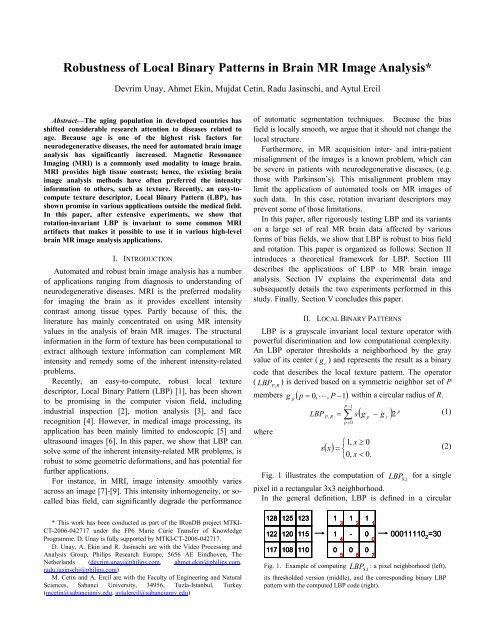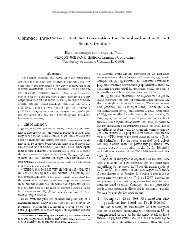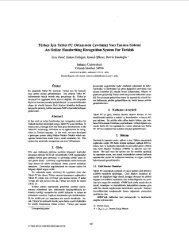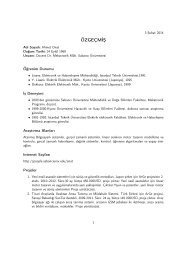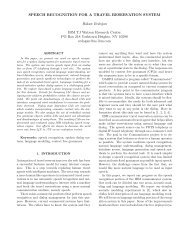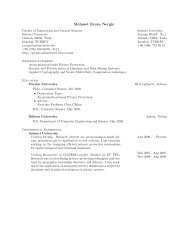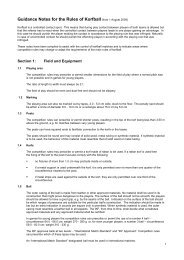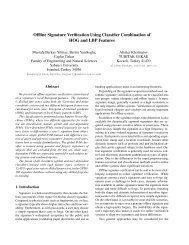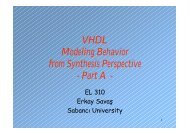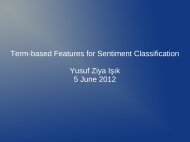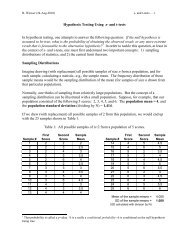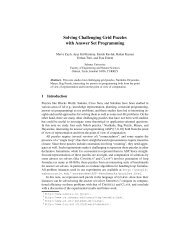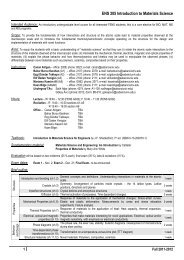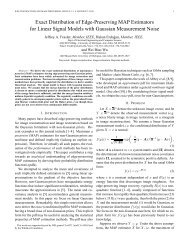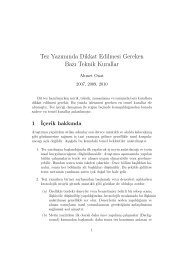( ) Robustness of Local Binary Patterns in Brain MR Image Analysis*
( ) Robustness of Local Binary Patterns in Brain MR Image Analysis*
( ) Robustness of Local Binary Patterns in Brain MR Image Analysis*
Create successful ePaper yourself
Turn your PDF publications into a flip-book with our unique Google optimized e-Paper software.
<strong>Robustness</strong> <strong>of</strong> <strong>Local</strong> <strong>B<strong>in</strong>ary</strong> <strong>Patterns</strong> <strong>in</strong> Bra<strong>in</strong> <strong>MR</strong> <strong>Image</strong> <strong>Analysis*</strong><br />
Devrim Unay, Ahmet Ek<strong>in</strong>, Mujdat Cet<strong>in</strong>, Radu Jas<strong>in</strong>schi, and Aytul Ercil<br />
Abstract—The ag<strong>in</strong>g population <strong>in</strong> developed countries has<br />
shifted considerable research attention to diseases related to<br />
age. Because age is one <strong>of</strong> the highest risk factors for<br />
neurodegenerative diseases, the need for automated bra<strong>in</strong> image<br />
analysis has significantly <strong>in</strong>creased. Magnetic Resonance<br />
Imag<strong>in</strong>g (<strong>MR</strong>I) is a commonly used modality to image bra<strong>in</strong>.<br />
<strong>MR</strong>I provides high tissue contrast; hence, the exist<strong>in</strong>g bra<strong>in</strong><br />
image analysis methods have <strong>of</strong>ten preferred the <strong>in</strong>tensity<br />
<strong>in</strong>formation to others, such as texture. Recently, an easy-tocompute<br />
texture descriptor, <strong>Local</strong> <strong>B<strong>in</strong>ary</strong> Pattern (LBP), has<br />
shown promise <strong>in</strong> various applications outside the medical field.<br />
In this paper, after extensive experiments, we show that<br />
rotation-<strong>in</strong>variant LBP is <strong>in</strong>variant to some common <strong>MR</strong>I<br />
artifacts that makes it possible to use it <strong>in</strong> various high-level<br />
bra<strong>in</strong> <strong>MR</strong> image analysis applications.<br />
I. INTRODUCTION<br />
Automated and robust bra<strong>in</strong> image analysis has a number<br />
<strong>of</strong> applications rang<strong>in</strong>g from diagnosis to understand<strong>in</strong>g <strong>of</strong><br />
neurodegenerative diseases. <strong>MR</strong>I is the preferred modality<br />
for imag<strong>in</strong>g the bra<strong>in</strong> as it provides excellent <strong>in</strong>tensity<br />
contrast among tissue types. Partly because <strong>of</strong> this, the<br />
literature has ma<strong>in</strong>ly concentrated on us<strong>in</strong>g <strong>MR</strong> <strong>in</strong>tensity<br />
values <strong>in</strong> the analysis <strong>of</strong> bra<strong>in</strong> <strong>MR</strong> images. The structural<br />
<strong>in</strong>formation <strong>in</strong> the form <strong>of</strong> texture has been computational to<br />
extract although texture <strong>in</strong>formation can complement <strong>MR</strong><br />
<strong>in</strong>tensity and remedy some <strong>of</strong> the <strong>in</strong>herent <strong>in</strong>tensity-related<br />
problems.<br />
Recently, an easy-to-compute, robust local texture<br />
descriptor, <strong>Local</strong> <strong>B<strong>in</strong>ary</strong> Pattern (LBP) [1], has been shown<br />
to be promis<strong>in</strong>g <strong>in</strong> the computer vision field, <strong>in</strong>clud<strong>in</strong>g<br />
<strong>in</strong>dustrial <strong>in</strong>spection [2], motion analysis [3], and face<br />
recognition [4]. However, <strong>in</strong> medical image process<strong>in</strong>g, its<br />
application has been ma<strong>in</strong>ly limited to endoscopic [5] and<br />
ultrasound images [6]. In this paper, we show that LBP can<br />
solve some <strong>of</strong> the <strong>in</strong>herent <strong>in</strong>tensity-related <strong>MR</strong> problems, is<br />
robust to some geometric deformations, and has potential for<br />
further applications.<br />
For <strong>in</strong>stance, <strong>in</strong> <strong>MR</strong>I, image <strong>in</strong>tensity smoothly varies<br />
across an image [7]-[9]. This <strong>in</strong>tensity <strong>in</strong>homogeneity, or socalled<br />
bias field, can significantly degrade the performance<br />
* This work has been conducted as part <strong>of</strong> the IRonDB project MTKI-<br />
CT-2006-042717 under the FP6 Marie Curie Transfer <strong>of</strong> Knowledge<br />
Programme. D. Unay is fully supported by MTKI-CT-2006-042717.<br />
D. Unay, A. Ek<strong>in</strong> and R. Jas<strong>in</strong>schi are with the Video Process<strong>in</strong>g and<br />
Analysis Group, Philips Research Europe, 5656 AE E<strong>in</strong>dhoven, The<br />
Netherlands (devrim.unay@philips.com, ahmet.ek<strong>in</strong>@philips.com,<br />
radu.jas<strong>in</strong>schi@philips.com)<br />
M. Cet<strong>in</strong> and A. Ercil are with the Faculty <strong>of</strong> Eng<strong>in</strong>eer<strong>in</strong>g and Natural<br />
Sciences, Sabanci University, 34956, Tuzla-Istanbul, Turkey<br />
(mcet<strong>in</strong>@sabanciuniv.edu, aytulercil@sabanciuniv.edu)<br />
<strong>of</strong> automatic segmentation techniques. Because the bias<br />
field is locally smooth, we argue that it should not change the<br />
local structure.<br />
Furthermore, <strong>in</strong> <strong>MR</strong> acquisition <strong>in</strong>ter- and <strong>in</strong>tra-patient<br />
misalignment <strong>of</strong> the images is a known problem, which can<br />
be severe <strong>in</strong> patients with neurodegenerative diseases, (e.g.<br />
those with Park<strong>in</strong>son’s). This misalignment problem may<br />
limit the application <strong>of</strong> automated tools on <strong>MR</strong> images <strong>of</strong><br />
such data. In this case, rotation <strong>in</strong>variant descriptors may<br />
prevent some <strong>of</strong> those limitations.<br />
In this paper, after rigorously test<strong>in</strong>g LBP and its variants<br />
on a large set <strong>of</strong> real <strong>MR</strong> bra<strong>in</strong> data affected by various<br />
forms <strong>of</strong> bias fields, we show that LBP is robust to bias field<br />
and rotation. This paper is organized as follows: Section II<br />
<strong>in</strong>troduces a theoretical framework for LBP. Section III<br />
describes the applications <strong>of</strong> LBP to <strong>MR</strong> bra<strong>in</strong> image<br />
analysis. Section IV expla<strong>in</strong>s the experimental data and<br />
subsequently details the two experiments performed <strong>in</strong> this<br />
study. F<strong>in</strong>ally, Section V concludes this paper.<br />
II. LOCAL BINARY PATTERNS<br />
LBP is a grayscale <strong>in</strong>variant local texture operator with<br />
powerful discrim<strong>in</strong>ation and low computational complexity.<br />
An LBP operator thresholds a neighborhood by the gray<br />
value <strong>of</strong> its center ( g ) and represents the result as a b<strong>in</strong>ary<br />
c<br />
code that describes the local texture pattern. The operator<br />
( LBP<br />
P ,<br />
) is derived based on a symmetric neighbor set <strong>of</strong> P<br />
R<br />
g p<br />
p = 0,<br />
L , P −1<br />
with<strong>in</strong> a circular radius <strong>of</strong> R.<br />
members ( )<br />
where<br />
( g − g )<br />
P<br />
∑ − 1<br />
p<br />
P , R<br />
= s<br />
p c<br />
2<br />
p = 0<br />
LBP (1)<br />
⎧1,<br />
x ≥ 0<br />
s ( x)<br />
= ⎨<br />
(2)<br />
⎩0,<br />
x < 0.<br />
Fig. 1 illustrates the computation <strong>of</strong> LBP for a s<strong>in</strong>gle<br />
8, 1<br />
pixel <strong>in</strong> a rectangular 3x3 neighborhood.<br />
In the general def<strong>in</strong>ition, LBP is def<strong>in</strong>ed <strong>in</strong> a circular<br />
128 125<br />
123<br />
122 120<br />
115 1 -<br />
0<br />
00011110 2<br />
=30<br />
4<br />
0<br />
117 108<br />
110<br />
1 1<br />
3<br />
2<br />
0 0<br />
5<br />
6<br />
Fig. 1. Example <strong>of</strong> comput<strong>in</strong>g LBP<br />
1<br />
1<br />
0<br />
7<br />
8,1<br />
: a pixel neighborhood (left),<br />
its thresholded version (middle), and the correspond<strong>in</strong>g b<strong>in</strong>ary LBP<br />
pattern with the computed LBP code (right).
symmetric neighborhood which requires <strong>in</strong>terpolation <strong>of</strong><br />
<strong>in</strong>tensity values for exact computation. In order to keep<br />
computation simple, <strong>in</strong> this study we decided to use the three<br />
rectangular neighborhoods as shown <strong>in</strong> Fig. 2.<br />
g<br />
c<br />
LBP<br />
8,1<br />
g<br />
c<br />
LBP<br />
A. Rotation Invariant <strong>Patterns</strong><br />
The LBP<br />
P ,<br />
operator can produce 2 P different output values<br />
R<br />
from the P neighbor pixels. As g is always assigned to be<br />
0<br />
the gray value <strong>of</strong> neighbor to the right <strong>of</strong> g , rotation will<br />
result <strong>in</strong> a different LBP<br />
P ,<br />
value for the same b<strong>in</strong>ary<br />
R<br />
pattern. One way to elim<strong>in</strong>ate the effect <strong>of</strong> rotation is to<br />
perform a bitwise shift operation on the b<strong>in</strong>ary pattern P-1<br />
times and assign the LBP value that is the smallest, which is<br />
ri<br />
now referred to as LBP ,<br />
(Fig. 3).<br />
P R<br />
B. “Uniform” <strong>Patterns</strong><br />
16,2<br />
A b<strong>in</strong>ary pattern is called “uniform” if it conta<strong>in</strong>s at most<br />
2 spatial transitions (bitwise 0/1 changes) [1]. Based on this<br />
riu2<br />
uniformity concept, a new LBP value ( LBP ) can be<br />
c<br />
P,<br />
R<br />
computed by summ<strong>in</strong>g the bit values <strong>of</strong> a rotation <strong>in</strong>variant<br />
b<strong>in</strong>ary pattern if it is uniform, or a miscellaneous label P+1<br />
g<br />
c<br />
LBP<br />
24,3<br />
Fig. 2. The rectangular neighborhoods <strong>of</strong> LBP used <strong>in</strong> this study.<br />
Gray-shaded rectangles refer to the pixels belong<strong>in</strong>g to the<br />
correspond<strong>in</strong>g neighborhood.<br />
00011110 2 = 30<br />
00111100 2 = 60<br />
01111000 2 =120<br />
11110000 2 =240<br />
11100001 2 =225<br />
11000011 2 =195<br />
10000111 2 =135<br />
00001111 2 = 15<br />
LBP<br />
ri<br />
8 ,1<br />
=<br />
Fig. 3. Example <strong>of</strong> comput<strong>in</strong>g rotation <strong>in</strong>variant LBP.<br />
LBP 1<br />
ri<br />
spatial<br />
8 ,<br />
transitions<br />
15<br />
LBP<br />
00000000 2 0 0<br />
11111111 2 0 8<br />
00000001 2 2 1<br />
00000011 2 2 2<br />
00001011 2 4 9<br />
riu<br />
2<br />
8,1<br />
Fig. 4. Example <strong>of</strong> comput<strong>in</strong>g rotation <strong>in</strong>variant and uniform LBP.<br />
can be assigned if it is nonuniform (Fig. 4).<br />
In this study, robustness <strong>of</strong> simple ( LBP<br />
P ,<br />
), rotation<br />
R<br />
ri<br />
<strong>in</strong>variant ( LBP<br />
P ,<br />
), and rotation <strong>in</strong>variant and uniform<br />
R<br />
riu2<br />
( LBP<br />
P,<br />
R<br />
) LBP features at three different rectangular<br />
neighborhoods (Fig. 2) are tested relative to bias field and<br />
rotation.<br />
III. APPLICATIONS OF LBP TO <strong>MR</strong> BRAIN IMAGE ANALYSIS<br />
In <strong>MR</strong>I patient is subjected to different magnetic fields at<br />
specific orientations. The protons (hydrogen atoms) <strong>in</strong> the<br />
patient’s body respond to these fields by differential decay<br />
and recovery signals, which are acquired by the <strong>MR</strong> mach<strong>in</strong>e<br />
and then converted to high contrast images. Due to factors<br />
like poor radio-frequency gradient uniformity, static field<br />
<strong>in</strong>homogeneity, radio-frequency penetration, gradient-driven<br />
eddy currents, and patient anatomy and position, pixel<br />
<strong>in</strong>tensities <strong>in</strong> <strong>MR</strong> images smoothly vary. This variation,<br />
known as <strong>in</strong>tensity <strong>in</strong>homogeneity/nonuniformity or bias<br />
field, has little impact on visual diagnosis, but its impact on<br />
the performance <strong>of</strong> automatic segmentation methods can be<br />
catastrophic due to <strong>in</strong>creased overlaps between <strong>in</strong>tensities <strong>of</strong><br />
different tissues.<br />
Furthermore, acquisition times <strong>of</strong> <strong>MR</strong>I are generally <strong>in</strong> the<br />
order <strong>of</strong> 10-20 m<strong>in</strong>utes, dur<strong>in</strong>g which patients (especially<br />
those with Park<strong>in</strong>son’s disease) tend to move that results <strong>in</strong><br />
spatially misaligned images. A common solution for this<br />
problem is registration, which may not be favored <strong>in</strong> some<br />
applications due to its computational expense and<br />
complexity. Hence, textural descriptors for <strong>MR</strong> images that<br />
are consistent <strong>in</strong> vary<strong>in</strong>g <strong>in</strong>tensities as well as geometric<br />
transformations like rotation will be very valuable.<br />
A. Experimental Data<br />
IV. RESULTS<br />
The database used <strong>in</strong> this study consists <strong>of</strong> dual (T2 and<br />
Proton Density) <strong>MR</strong> scans from 549 subjects, which are<br />
acquired on a Philips Intera 1.5T whole body scanner at<br />
Leiden University Medical Center. We used dual-sp<strong>in</strong> echo<br />
weighted images (TR/TE1/TE2: 3000/27/120 ms, FLIP: 90)<br />
with 220mm FOV, 3mm slice thickness, no slice gap and<br />
256x256 matrix.<br />
In order to test robustness <strong>of</strong> LBP with respect to <strong>in</strong>tensity<br />
variations, three simulated bias fields from the Bra<strong>in</strong>Web<br />
<strong>MR</strong> simulator [10] are used (Fig. 5). These bias fields<br />
provide smooth variations <strong>of</strong> <strong>in</strong>tensity across the image.<br />
Furthermore, we applied l<strong>in</strong>ear transformation to obta<strong>in</strong> a<br />
new bias field <strong>of</strong> each with 10%, 20%, 30% and 40%<br />
A B C<br />
Fig. 5. Examples <strong>of</strong> simulated bias fields used <strong>in</strong> this study, where<br />
<strong>in</strong>tensity variations are exaggerated for visual purposes.
<strong>in</strong>tensity variations. Based on the conventional assumption<br />
that the bias field <strong>in</strong> <strong>MR</strong> images is multiplicative [7]-[9], we<br />
degraded the orig<strong>in</strong>al images by multiply<strong>in</strong>g them with the<br />
result<strong>in</strong>g bias fields.<br />
B. Evaluation Method<br />
The degree <strong>of</strong> dissimilarity between the LBP values <strong>of</strong> the<br />
orig<strong>in</strong>al and the degraded (by the bias field and rotation)<br />
images is computed on the correspond<strong>in</strong>g normalized LBP<br />
histograms us<strong>in</strong>g the Bhattacharyya distance (3) and the<br />
histogram <strong>in</strong>tersection (4):<br />
L<br />
∑ − 1<br />
i=<br />
0<br />
L 1<br />
( i) ⋅ q( i)<br />
d = 1−<br />
p<br />
(3)<br />
B<br />
[ p( i) , q( i)<br />
]<br />
− ∑ − d = 1 m<strong>in</strong><br />
(4)<br />
I<br />
i=<br />
0<br />
where p and q are the two histograms with L-b<strong>in</strong>s. The<br />
dissimilarity scores for both measures fall <strong>in</strong> the range <strong>of</strong><br />
[0,1], where 0 means that the two images are perfectly<br />
similar. Please note that as we observed similar results with<br />
both measures for all the tests, the follow<strong>in</strong>g sections provide<br />
the results based on only Bhattacharyya measure.<br />
C. <strong>Robustness</strong> to Bias Field<br />
We first tested the consistency <strong>of</strong> LBP relative to the bias<br />
field, where several LBP operators are applied on the<br />
orig<strong>in</strong>al images as well as on those degraded by the bias<br />
fields. Table I displays dissimilarity scores <strong>of</strong> this test for all<br />
the bias fields and several LBP features, while Fig.6 shows<br />
the result <strong>of</strong> LBP . We observe a steady <strong>in</strong>crease <strong>in</strong><br />
8, 1<br />
dissimilarity values with the bias field strength. Bias field B<br />
provides the highest dissimilarity score for all strengths,<br />
TABLE I<br />
EFFECT OF BIAS FIELD ON VARIOUS LBP FEATURES<br />
because it has larger spatial variation. All the dissimilarity<br />
values are below 0.04%, which shows that the LBP features<br />
are robust to the bias fields.<br />
D. <strong>Robustness</strong> to Rotation<br />
In order to test the robustness <strong>of</strong> LBP features relative to<br />
rotation, we have rotated the orig<strong>in</strong>al images by 15°, 30°,<br />
45°, and 60° at clockwise and counterclockwise directions<br />
us<strong>in</strong>g three different <strong>in</strong>terpolation methods: nearest neighbor,<br />
bil<strong>in</strong>ear, and bicubic (presented from the simplest to the most<br />
complex, respectively). Fig. 7 displays examples <strong>of</strong> some <strong>of</strong><br />
the rotated images.<br />
Fig. 7. Examples <strong>of</strong> T2 (1 st and 3 rd from the left) and Proton Density (2 nd<br />
and 4 th from the left) images rotated by 15°, 30°, 45° and 60°, respectively<br />
us<strong>in</strong>g bicubic <strong>in</strong>terpolation.<br />
Table II displays the average dissimilarity scores <strong>of</strong> this<br />
test for all the LBP features when the images are rotated by<br />
various angles <strong>in</strong> both clockwise and counterclockwise<br />
directions us<strong>in</strong>g three <strong>in</strong>terpolation methods. We generally<br />
observe that dissimilarity values decrease when 1) the<br />
complexity <strong>of</strong> the <strong>in</strong>terpolation method <strong>in</strong>creases, 2) the<br />
rotation <strong>in</strong>variancy and the uniformity is <strong>in</strong>troduced to LBP,<br />
and 3) the radius <strong>of</strong> the LBP operator is <strong>in</strong>creased. The<br />
former observation is coherent with the fact that the<br />
complexity <strong>of</strong> the <strong>in</strong>terpolation method is directly related to<br />
the quality <strong>of</strong> the result<strong>in</strong>g rotated image. The second<br />
observation is understandable when we consider that the<br />
rotation <strong>in</strong>variant and “uniform” LBP patterns correspond to<br />
the primitive micr<strong>of</strong>eatures <strong>in</strong> the image [1]. F<strong>in</strong>ally, the<br />
third observation is mean<strong>in</strong>gful <strong>in</strong> the sense that as the<br />
neighborhood gets bigger, the effect <strong>of</strong> degradation caused<br />
by rotation gets weaker due to the <strong>in</strong>creased radius as well as<br />
TABLE II<br />
EFFECT OF ROTATION ON VARIOUS LBP FEATURES<br />
Values <strong>in</strong> the table are the dissimilarity scores (10 -4 ).<br />
Fig. 6. <strong>Robustness</strong> <strong>of</strong> LBP 8,1 relative to vary<strong>in</strong>g bias field strength.<br />
Values <strong>in</strong> the table are the dissimilarity scores (10 -2 ).
higher number <strong>of</strong> neighbors present.<br />
Fig. 8 and 9 display the effect <strong>of</strong> the <strong>in</strong>terpolation method<br />
and the LBP feature type relative to rotation, respectively.<br />
These two figures visually support the observations we made<br />
previously: dissimilarity <strong>in</strong>creases with the rotation angle,<br />
the complexity <strong>of</strong> the <strong>in</strong>terpolation method has <strong>in</strong>verse<br />
relation with the dissimilarity, and rotation <strong>in</strong>variant and<br />
riu2<br />
uniform LBP features ( LBP ) are the most robust to<br />
rotation, while simple LBP features ( LBP<br />
8, 1<br />
8,1<br />
) are the least.<br />
In <strong>MR</strong>I, some common artifacts, like <strong>in</strong>tensity variation<br />
across the image and spatial misalignment <strong>of</strong> images, can<br />
pose great difficulties for automatic analysis methods.<br />
Hence, LBP that is <strong>in</strong>variant to gray-scale and rotation may<br />
be a robust choice for <strong>MR</strong> bra<strong>in</strong> image analysis.<br />
Therefore, <strong>in</strong> this study we tested the robustness <strong>of</strong> LBP to<br />
<strong>MR</strong> bias field as well as rotation. Results showed that LBP is<br />
robust to bias field even at 40% <strong>in</strong>tensity variations.<br />
Secondly, orig<strong>in</strong>al images are rotated by up to 60° <strong>in</strong> both<br />
clockwise and counterclockwise directions us<strong>in</strong>g three<br />
different <strong>in</strong>terpolation methods. LBP was aga<strong>in</strong> found to be<br />
robust to rotation.<br />
Results <strong>of</strong> this study lead to the fact that LBP, which is<br />
computationally simple and robust to bias field and rotation,<br />
can be a promis<strong>in</strong>g texture descriptor <strong>in</strong> various <strong>MR</strong> bra<strong>in</strong><br />
image analysis applications, like image normalization, tissue<br />
segmentation and abnormality detection.<br />
Fig. 8. <strong>Robustness</strong> <strong>of</strong> LBP 8,1 relative to different <strong>in</strong>terpolation<br />
methods for rotation.<br />
ACKNOWLEDGMENT<br />
The authors would like to thank the Marie Curie<br />
Programme <strong>of</strong> the European Commission for the support to<br />
FP6 IRonDB project MTKI-CT-2006-042717. We also<br />
would like to thank Pr<strong>of</strong>. Mark van Buchem and Dr. Jeroen<br />
van der Grond from the Department <strong>of</strong> Radiology, Leiden<br />
University Medical Center for the discussions and the data<br />
support.<br />
Fig. 9. <strong>Robustness</strong> <strong>of</strong> different LBP 8,1 features relative to rotation by<br />
bicubic <strong>in</strong>terpolation.<br />
E. Computational Expense <strong>of</strong> LBP<br />
We measured the average process time <strong>of</strong> comput<strong>in</strong>g LBP<br />
rui2<br />
<strong>in</strong> the range <strong>of</strong> 60 ( LBP ) - 1100 (<br />
8, 1<br />
LBP ) ms per slice on<br />
24,3<br />
an Intel Pentium processor (2.8 GHz) with 1G memory.<br />
However, the computation time can be considerably reduced<br />
us<strong>in</strong>g look-up tables (for rotation <strong>in</strong>variant and uniform LBP<br />
codes: the ma<strong>in</strong> bottlenecks <strong>of</strong> the current implementation<br />
that is <strong>in</strong> C) and optimized s<strong>of</strong>tware.<br />
V. CONCLUSIONS<br />
<strong>MR</strong>I provides high tissue contrast, which makes <strong>MR</strong> the<br />
preferred modality to image bra<strong>in</strong>. The exist<strong>in</strong>g bra<strong>in</strong> image<br />
analysis methods <strong>of</strong>ten focus on the <strong>in</strong>tensity <strong>in</strong>formation<br />
only. LBP is a computationally efficient, gray-scale and<br />
rotation <strong>in</strong>variant texture operator that can provide<br />
complementary <strong>in</strong>formation for bra<strong>in</strong> image analysis.<br />
REFERENCES<br />
[1] T. Ojala, M. Peitikä<strong>in</strong>en, and T. Mäenpää, “Multiresolution gray-scale<br />
and rotation <strong>in</strong>variant texture classification with local b<strong>in</strong>ary<br />
patterns,” IEEE Trans. Pattern Analysis and. Mach<strong>in</strong>e Intelligence,<br />
vol. 24, pp. 971–987, July 2002.<br />
[2] T. Mäenpää, M. Turt<strong>in</strong>en,and M. Peitikä<strong>in</strong>en, “Real-time surface<br />
<strong>in</strong>spection by texture”, Real-Time Imag<strong>in</strong>g, vol. 9, pp. 289–296,<br />
2003.<br />
[3] M. Heikkilä,and M. Peitikä<strong>in</strong>en, “A texture-based method for<br />
model<strong>in</strong>g the background and detect<strong>in</strong>g mov<strong>in</strong>g objects”, IEEE<br />
Ttrans. Pattern Analysis and Mach<strong>in</strong>e Intelligence, vol. 28, pp. 657–<br />
662, 2006.<br />
[4] T. Ahonen, A. Hadid, and M. Peitikä<strong>in</strong>en, “Face description with<br />
local b<strong>in</strong>ary patterns: application to face recognition”, ”, IEEE Ttrans.<br />
Pattern Analysis and Mach<strong>in</strong>e Intelligence, vol. 28, pp. 2037–2041,<br />
2006.<br />
[5] D. K. Iakovidis, D. E. Maroulis, and S. A. Karkanis, “An <strong>in</strong>telligent<br />
system for automatic detection <strong>of</strong> gastro<strong>in</strong>test<strong>in</strong>al adenomas <strong>in</strong> video<br />
endoscopy”, Computers <strong>in</strong> Biology and Medic<strong>in</strong>e, vol. 36, pp. 1084–<br />
1103, 2006.<br />
[6] O. Pujol, D. Rotger, P. Radeva, O. Rodriguez, and J. Mauri, “Near<br />
real-time plaque segmentation <strong>of</strong> IVUS”, <strong>in</strong> Proc. Computers <strong>in</strong><br />
Cardiology, Thessaloniki, Greece, September 2003, pp. 69–73.<br />
[7] J. G. Sled, A. P. Zijdenbos, and A. C. Evans, “A nonparametric<br />
method for automatic correction <strong>of</strong> <strong>in</strong>tensity nonuniformity <strong>in</strong> <strong>MR</strong>I<br />
data”, IEEE Trans. Medical Imag<strong>in</strong>g, vol. 17, pp.87–97, February<br />
1998.<br />
[8] B. Likar, M. A. Viergever, and F. Pernuš, “Retrospective correction <strong>of</strong><br />
<strong>MR</strong> <strong>in</strong>tensity <strong>in</strong>homogeneity by <strong>in</strong>formation m<strong>in</strong>imization”, IEEE<br />
Trans. Medical Imag<strong>in</strong>g, vol. 20, pp. 1398–1410, December 2001.<br />
[9] U. Vovk, F. Pernuš, and B. Likar, “<strong>MR</strong>I Intensity <strong>in</strong>homogeneity<br />
correction by comb<strong>in</strong><strong>in</strong>g <strong>in</strong>tensity and spatial <strong>in</strong>formation”, Phys.<br />
Med. Biol., vol. 49, pp. 4119–4133, 2004.<br />
[10] [Onl<strong>in</strong>e] http://www.bic.mni.mcgill.ca/bra<strong>in</strong>web/


